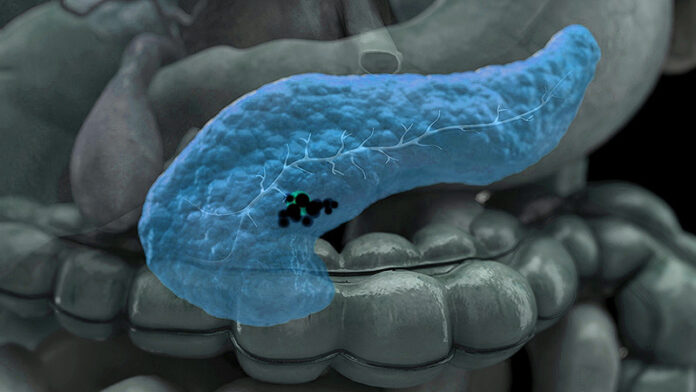[ad_1]
For patients with inoperable pancreatic cancer, higher dose ablative radiation after chemotherapy induction may extend life, say investigators from Memorial Sloan Kettering Cancer Center in New York City.
When delivering the radiation, adjustments need to be made for respiratory and gastrointestinal functions, they emphasize; this allows a much larger cumulative dose of radiation to be delivered.
The report was published online March 11 in JAMA Oncology.
“Any hope of improving outcomes in” locally advanced pancreatic cancer requires dose escalation beyond 33 Gy in 5 fractions, said lead investigator Marsha Reyngold, MD, PhD, a radiation oncologist at Memorial Sloan Kettering, in a 2019 paper.
Concerns about irradiating healthy tissue have previously kept stereotactic body radiotherapy (SBRT) to a limit of 33 Gy in 3-5 fractions for pancreas tumors, which yields a cumulative biologically effective dose (BED) of about 55 Gy.
Going beyond that point is now possible because “emerging radiation techniques that address organ motion have enabled curative radiation doses” in unresectable disease, Reyngold and colleagues comment.
The team delivered SBRT while making adjustments for respiratory motion and day-to-day shifts in the shapes of luminal gastrointestinal organs, and delivered a cumulative BED of 98 Gy.
In their review of 119 consecutive patients who received 98 Gy, they report that 38% of patients were alive at 2 years.
An earlier report from another group of investigators shows among 49 patients who received 55 Gy, only 18% of patients were alive at 2 years.
Concluding that their novel radiotherapy technique is associated with “with durable locoregional tumor control and favorable survival,” the researchers add that prospective randomized trials are warranted.
The MSK team acknowledges the part played by chemotherapy induction. Almost all the subjects had induction chemotherapy for a median of 4 months, including 66 patients with mFOLFIRINOX (fluorouracil, oxaliplatin, irinotecan, leucovorin) and 37 with gemcitabine/nab-paclitaxel. Both regimens “have been important advances” for pancreatic cancer, and “undoubtedly… contributed to the favorable outcomes in this study,” they commented.
Table of Contents
Not Quite Ready for Prime Time
The results are “encouraging,” but not everyone has the resources and expertise of Memorial Sloan Kettering, said David Horowitz, MD, a radiation oncologist at Columbia University, New York City, and colleagues writing in an accompanying editorial.
This approach “still place[s] normal tissues very close to potentially injurious doses of radiation, and the results reported must be interpreted cautiously before being widely adopted,” they write. It is unclear if such operator-dependent methods “can be applied outside of a single center,” they add.
Like the investigators, the editorialists called for a randomized trial. “The onus is on the radiation oncology community to demonstrate that our technically exquisite capabilities translate into treatments that finally move the needle for inoperable pancreatic cancer,” they said.
Study Details
In their study, the Memorial Sloan Kettering team opted for protracted treatment with an increased number of SBRT fractions in order to boost the dose while keeping adjacent organs safe. They also went against radiation dogma, and they intentionally generated hotspots in tumors to overcome radioresistant portions.
The team reports that 96 patients with tumors closer than 1 cm to the stomach or bowel were treated with 75 Gy in 25 fractions for a BED of 97.5 Gy.
The remaining 23 patients with tumors farther away received 67.5 Gy in 15 fractions for a BED of 97.88 Gy.
Daily cone-beam CT was used to guide imaging, and radiation was delivered by Varian linear accelerators that adjusted for respiratory motion.
The safety measures paid off; there were no grade 4 or 5 toxicities and only 10 patients (8%) had grade 3 gastrointestinal hemorrhage. Eight had been on concurrent anticoagulation, and two required endoscopic management.
Median overall survival (OS) after diagnosis was 26.8 months and median progression free survival (PFS) 13.2 months. Median OS after radiation was 18.2 months and PFS 6.3 months. One year after radiation, 74% of patients were alive.
Central tumor hotspots — along with reductions in carbohydrate antigen 19-9 — were the only factors associated with improved progression-free survival on multivariate analysis.
No funding was reported. Reyngold has disclosed no relevant financial relationships, but several co-authors reported grants and/or personal fees from AstraZeneca and other companies. The editorialists have disclosed no relevant financial relationships.
JAMA Oncol. Published online March 11, 2021. Abstract, Editorial
M. Alexander Otto is a physician assistant with a master’s degree in medical science and a Newhouse journalism degree from Syracuse University. He is an award-winning medical journalist who worked for McClatchy and Bloomberg before joining Medscape, and also an MIT Knight Science Journalism fellow. Email: [email protected].
For more from Medscape Oncology, join us on Twitter and Facebook
[ad_2]
Source link












